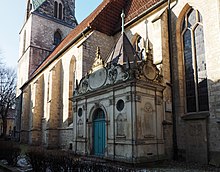Johann Duve

Johann Duve (born March 8, 1611 in Hanover , † September 2, 1679 in Hanover) was a German merchant and banker .
Career
Born in Hanover as the descendant of an old patrician family and son of a silk merchant, he completed an apprenticeship as a merchant in Hamburg, before setting up a silk business after his return to Hanover in 1633. His descendants now live in Berlin and Merfeld near Dülmen. He joined the merchants' guild and built up a business that exceeded all companies known in Hanover in terms of versatility and expansion. The Thirty Years War favored Duve's rise. He received supplies from the army through the cloth trade, which he soon expanded to include grain, lead and powder. In 1643 he was appointed to the upper mountain factor, which granted him the privilege of mining all non-precious metals in the Harz Mountains (above all lead), a business that achieved 100,000 thalers a year. Duve also acquired production facilities for its trading goods as well as mills and farms for its grain trade.
Due to the turmoil of the Thirty Years' War, there was great poverty in Hanover, reinforced by the numerous refugees from the country. Duve then founded the poor house and orphanage on Schmiedestrasse in 1643 for 40 old and helpless men and women and for 60 orphans of both sexes. His concern was to get the poor and the infirm off the street, but he insisted that the healthy poor had to earn their own costs (which he then used as labor in his spinning and weaving mills).
In 1646 he was elected councilor of Hanover, which he initially refused and instead wanted to pay 500 thalers to the poor house. Finally he gave in to the urge. In his function as councilor he rebuilt mills that had been destroyed by floods and donated funds to avert the frequent flooding of the Leine. In addition, he was active as a building contractor, at the request of Duke Georg Wilhelm he took over the enlargement of the Neustadt, he built residential houses, which were called "Red or Blue Row" after their red or blue paint, followed by the "Kleine Duvenstrasse" “And the construction of the Neustadt church. In order to supply the Neustadt with water, he built a corresponding system.
Under the direction of Johann Duve, the Parnassus fountain was built on the Neustädter Markt at the instigation of Duke Johann Friedrich. However, this expensive facility did not work satisfactorily and was dismantled in 1802. In 1630 a storm destroyed the tower of the Kreuzkirche, which was rebuilt with the help of Duve. In 1655 a chapel with a family vault was added to the church. He and his family and some of his descendants were buried there. In 1663 he donated a new altar and the new painting of the market church in Hanover, whereby he and his wife were portrayed as a praying couple.

In 1666 he leased the municipal mint of Hanover. In 1674 the mint was withdrawn from him for minting bad coins, which resulted in great financial losses. In 1672 Duve had to pay 50,000 thalers bankruptcy debt for one of his sons. In 1675 Duve provided the Danish king with a loan of 180,000 thalers, for which he had pledged his entire property. The ship sank on the high seas and the king refused to repay. Duve went bankrupt in one fell swoop and was left with nothing overnight. According to legend, he had to look for accommodation in the Almshouse House of the Lord , which he founded in 1643, and died there in 1679. However, he died in his house on Markt an der Marktkirche , where, according to an old register, he lived until his death.
Commemoration
The chapel at the Kreuzkirche, a portrait medallion on the garden side of the New Town Hall and the Johann-Duve-Weg as a pedestrian and cycle path, which connects the Döhren district with Hemmingen , remind of Johann Duve in Hanover . In 1916 Georg Herting created the Duve Fountain , which is now located on the median of the Leibnizufer (transition to Calenberger Straße) and is also known as the Sämann Fountain. It was originally set up at Neustädter Markt . It is adorned with the sculpture of a sower. There is also a portrait of Johann Duve on the base.
Duve was one of the most distinctive figures of early capitalism . His significant contribution to the urban development of Hanover and the establishment of the poor house and orphanage on Schmiedestrasse gave him the reputation of a benefactor. Accordingly, he is represented as a sower on the Duve fountain.
literature
- Herbert Mundhenke: Duve, Johann. In: New German Biography (NDB). Volume 4, Duncker & Humblot, Berlin 1959, ISBN 3-428-00185-0 , pp. 208 f. ( Digitized version ).
- Waldemar R. Röhrbein in: Dirk Böttcher , Klaus Mlynek, Waldemar R. Röhrbein, Hugo Thielen : Hannoversches Biographisches Lexikon . From the beginning to the present. Schlütersche, Hannover 2002, ISBN 3-87706-706-9 , pp. 100-101.
- Herbert Röhrig : Johann Duve. Rise and fall of the first Hanoverian entrepreneur . In: Hannoversche Geschichtsblätter . NF 15 (1961), pp. 225-280.
Web links
Individual evidence
- ^ Herbert Röhrig: Johann Duve. Rise and fall of the first Hanoverian entrepreneur. In: Hannoversche Geschichtsblätter. NF 15 (1961), p. 268.
| personal data | |
|---|---|
| SURNAME | Duve, Johann |
| BRIEF DESCRIPTION | German merchant and banker |
| DATE OF BIRTH | March 8, 1611 |
| PLACE OF BIRTH | Hanover |
| DATE OF DEATH | September 2, 1679 |
| Place of death | Hanover |
